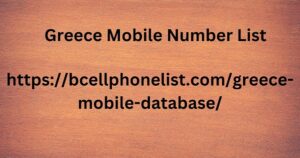Post by account_disabled on Mar 7, 2024 15:32:55 GMT 9.5
The always give a bad feeling. It all depends on how you use it. Marry stories with data for compelling content If story activates the emotional centers of the brain data activates the logic centers. Activating both at the same time can be incredibly powerful if done correctly. For example if you tell a story about someone your business or product has helped then combine that story with data that explains how much youve helped them your story becomes more trustworthy. In John Allen Paulos New York Times piece Stories vs.
Statistics he explains that people are afraid of committing two types of Greece Mobile Number List judgment errors observing something that is not really there Type error and missing something that is there Type error. Some people are more comfortable committing one type of error over the other depending on their personality types and this is where stories and statistics come into play. fJEBlMO.pngFor a certain type of consumer story is really all they need. Theyre ready to make a decision based purely on the emotional connection you make with them. But others arent so sure about your story.

Theyre less impressed by the flashy details.the form of hard numbers. Why do numbers make us trust While data and statistics can be woven into just about any form to support just about any theory we still think of numbers as unbiased objective unemotional. Perhaps this bias is a result of how our brains treat numerical information it just doesnt tickle the emotional parts of ourselves. We treat numbers with logic and illogical as it may be expect the same treatment from data in return. Its a bias we marketers can use especially when we know that while people are likely to act on their gut instinct they still confirm that instinct with logic. I would argue that we need to use data in this way as a confirmation of the story.
Statistics he explains that people are afraid of committing two types of Greece Mobile Number List judgment errors observing something that is not really there Type error and missing something that is there Type error. Some people are more comfortable committing one type of error over the other depending on their personality types and this is where stories and statistics come into play. fJEBlMO.pngFor a certain type of consumer story is really all they need. Theyre ready to make a decision based purely on the emotional connection you make with them. But others arent so sure about your story.

Theyre less impressed by the flashy details.the form of hard numbers. Why do numbers make us trust While data and statistics can be woven into just about any form to support just about any theory we still think of numbers as unbiased objective unemotional. Perhaps this bias is a result of how our brains treat numerical information it just doesnt tickle the emotional parts of ourselves. We treat numbers with logic and illogical as it may be expect the same treatment from data in return. Its a bias we marketers can use especially when we know that while people are likely to act on their gut instinct they still confirm that instinct with logic. I would argue that we need to use data in this way as a confirmation of the story.
